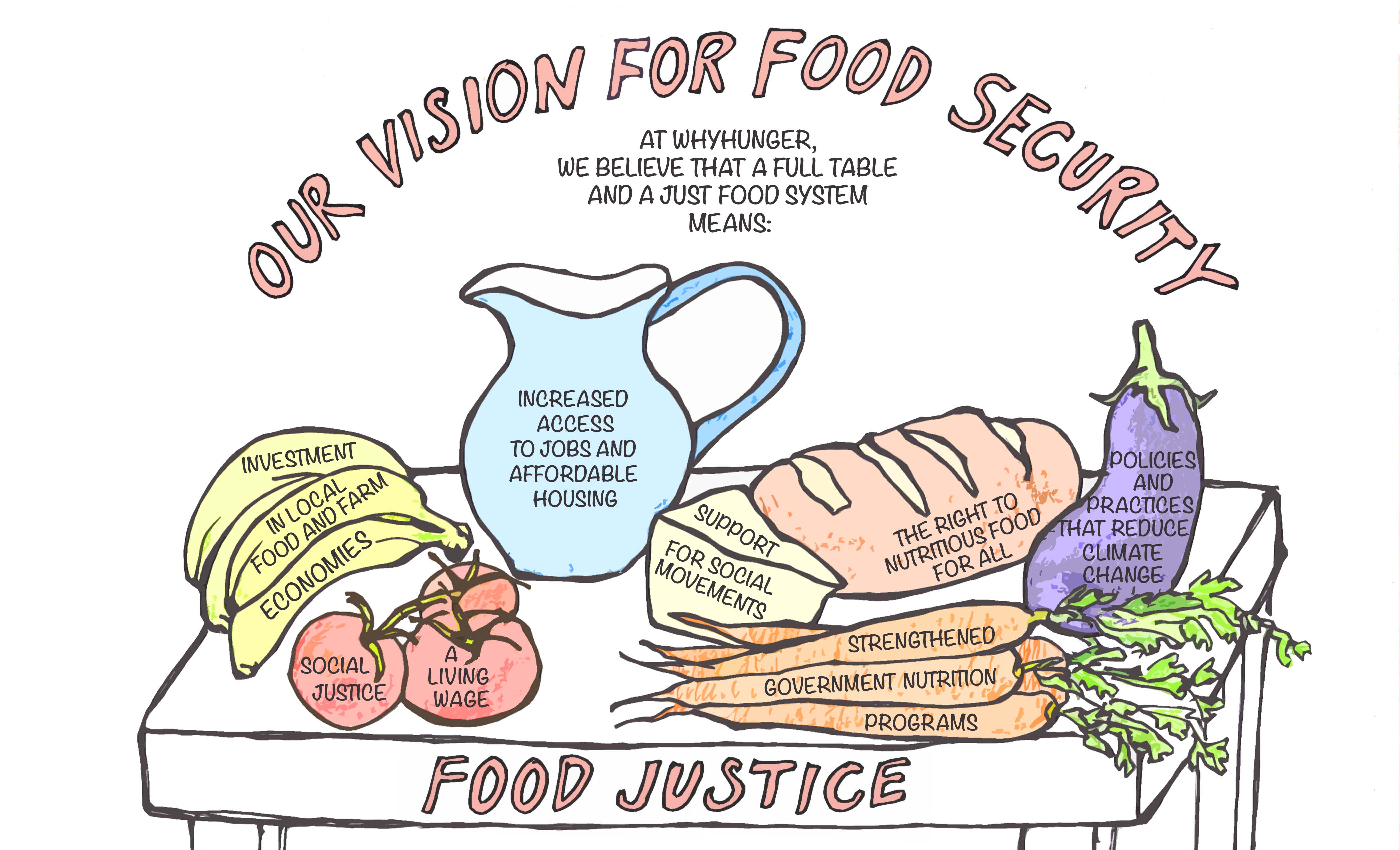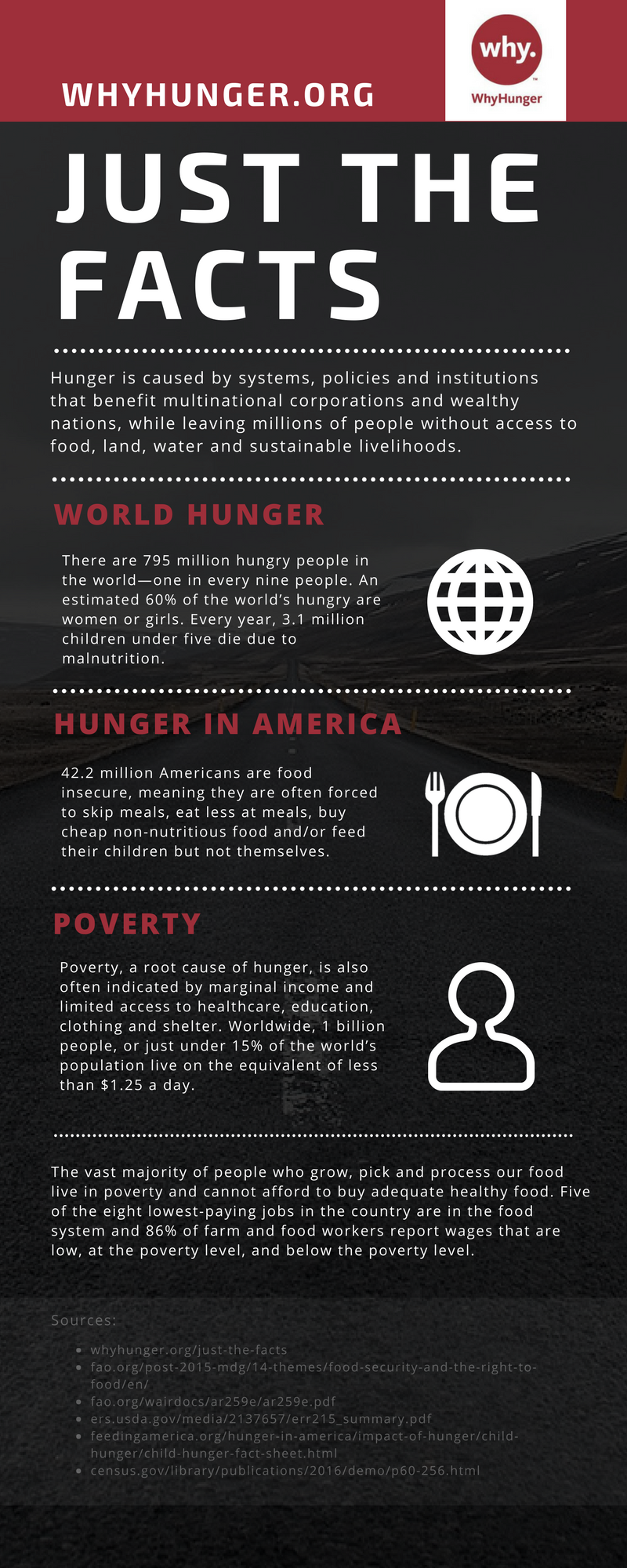Hunger in the U.S. | World Poverty & Hunger
 Hunger in the U.S. and around the world is caused by various complex social and economic factors of which much ink has been spilled. We realize that one web page can hardly do justice to all the facts and thoughts on this matter. Our main goal with this page is to provide a brief overview of up to date hunger facts in an attempt to educate the public about the realities and the root causes of hunger and poverty.
Hunger in the U.S. and around the world is caused by various complex social and economic factors of which much ink has been spilled. We realize that one web page can hardly do justice to all the facts and thoughts on this matter. Our main goal with this page is to provide a brief overview of up to date hunger facts in an attempt to educate the public about the realities and the root causes of hunger and poverty.
We know that the world can produce enough food to feed every person on earth1 So why is there still hunger and what can we do about it? The root causes of hunger are due to the systems, policies and institutions that benefit multinational corporations and wealthy nations, while leaving millions of people without access to food, land, water and sustainable livelihoods.
Our global food system is structured to value profits over people and planet.
In other words, hunger is caused by poverty and injustice.
WORLD HUNGER:
- There are 795 million hungry people in the world—one in every nine people2.*
- An estimated sixty percent of the world’s hungry are women or girls3.
- Every year, 3.1 million children under five die due to malnutrition.
* This is the number reported by the Food and Agriculture Organization (FAO) of the United Nations. Critics claim that the FAO data neglects larger issues of poverty, inequality and rising food prices. It is almost certain that the number of people facing hunger worldwide is even higher.
HUNGER IN AMERICA:
- 42.2 million Americans are food insecure,* meaning they are often forced to skip meals, eat less at meals, buy cheap non-nutritious food and/or feed their children but not themselves.4
- 13.1 million children in the US are food insecure.5
- There are 15.8 million U.S. households suffering from food insecurity – 12.7 percent of all U.S households.6
- 6.3 million U.S. households suffer from severe food insecurity, which means the people who live in them are often hungry.7
- 3 million households with children are food insecure at some time each year.8
- 45.5 million Americans currently rely on SNAP (Supplemental Assistance Program, formerly food stamps) to meet their food needs.9
- In 2012, 22 percent of SNAP users had no other form of cash income, suggesting that SNAP is the sole food source for millions of Americans.10
- Among SNAP households with children, more than 60 percent of work while receiving SNAP, and almost 90 percent are employed the prior or subsequent year. SNAP helps Americans return to work, and increasingly, it helps those who already work, but do not receive a sufficient wage to feed themselves or their families.11
- Many families suffering from hunger and poverty live in areas where fresh, unprocessed, healthy food is not available or is expensive, while the food they do have access to is nutritionally deficient.12
* The USDA defines ‘food insecure’ as “a household-level economic and social condition of limited or uncertain access to adequate food.” Characteristics of households with food insecurity include skipping or reducing the size of meals, not being able to afford a balanced meal, going whole days without eating, and going without food despite feeling hungry. Households with very low food security are characterized as having food intake reduced and eating patterns disrupted, because the household lacks money and other resources for food. For these households, 96 percent report skipping and reducing meals because of not having enough money for food.
POVERTY:
Poverty, a root cause of hunger, is also often indicated by marginal income and limited access to healthcare, education, clothing and shelter.
IN AMERICA:
- There are 43.1 million people living in poverty in the US, including 14.5 million children.15 That’s 1 in 5 American children.
- 2015 federal guidelines set the poverty rate at $24,257 for a family of four, but depending on a family’s specific city and state of residence, the actual minimum amount required to raise a family could be two or three times that.16
- The vast majority of people who grow, pick and process our food live in poverty and cannot afford to buy adequate healthy food. Five of the eight lowest-paying jobs in the country are in the food system17 and 86% of farm and food workers report wages that are low, at the poverty level, and below the poverty level.18
GLOBALLY:
- Worldwide, 1 billion people, or just under 15% of the world’s population live on the equivalent of less than $1.25 a day.
For more information on WHyHunger’s vision for a world free from hunger, visit Our Work.
Resources
-
- Food and Agriculture Organization:
- The State of Food Insecurity in the World 2015
- Gender Equality and Food Security: Women’s Empowerment as a Tool against Hunger
-
- United States Department of Agriculture:
- Household Food Security in the United States in 2013
- Definitions of Food Security
-
- Center of Budget and Policy Priorities:
- Introduction to SNAP
-
- Economic Research Service:
- Access to Affordable and Nutritious Food
-
- US Department of Health and Human Services:
- 2015 Poverty Guidelines
-
- United States Department of Labor, Bureau of Labor Statistics:
- Agricultural Workers Summary
-
- The World Bank:
- Poverty
- Joint Child Malnutrition Estimates
-
- World Health Organization:
- Children: Reducing Mortality
- 1Food and Agriculture Organization, The Post-2015 Development Agenda and the Millennium Development Goals, 2015. Accessed 08/30/15 //www.fao.org/post-2015-mdg/14-themes/food-security-and-the-right-to-food/en/
- 2Food and Agriculture Organization, The State ofFood Insecurity in the World 2015, 2015. Accessed 08/25/15. //www.fao.org/3/a-i4646e/index.html
- 3Food and Agriculture Organization, Gender Equality and Food Security: Women’s Empowerment as a Tool against Hunger, 2013. Accessed 08/25/15. //www.fao.org/wairdocs/ar259e/ar259e.pdf
- 4United States Department of Agriculture, Household Food Security in the United States in 2015. Accessed 09/19/16. //www.ers.usda.gov/media/2137657/err215_summary.pdf
- 5Feeding America, Child Hunger Facts. Accessed 09/19/2016. //www.feedingamerica.org/hunger-in-america/impact-of-hunger/child-hunger/child-hunger-fact-sheet.html
- 6Ibid.
- 7Center of Budget and Policy Priorities, Introduction to SNAP, 2015. Accessed 08/25/15. //www.cbpp.org//sites/default/files/atoms/files/policybasics-foodstamps.pdf
- 8United States Department of Agriculture, Characteristics of Supplemental Nutrition Assistance Program Households: Fiscal Year 2011, 2012. Accessed 08/25/15. //www.fns.usda.gov/sites/default/files/2011Characteristics.pdf
- 9Center of Budget and Policy Priorities: The Relationship Between SNAP and Work Among Low-Income Households, 2013. Accessed 08/25/15. //www.cbpp.org/research/the-relationship-between-snap-and-work-among-low-income-households
- 10Economic Research Service, Access to Affordable and Nutritious Food, 2009. Accessed 09/03/15. //www.ers.usda.gov/media/242654/ap036_reportsummary_1_.pdf
- 11United States Department of Agriculture, Definitions of Food Security, 2015. Accessed 08/25/15. //www.ers.usda.gov/topics/food-nutrition-assistance/food-security-in-the-us/definitions-of-food-security.aspx
- 12Ibid.
- 13United States Census Bureau, Income and Poverty in the United States: 2015. Accessed 09/16/16.https://www.census.gov/library/publications/2016/demo/p60-256.html
- 14US Department of Health and Human Services, 2015 Poverty Guidelines. Accessed 08/25/15. //aspe.hhs.gov/2015-poverty-guidelines#threshholds
- 15United States Census Bureau, Income and Poverty in the United States: 2015. Accessed 09/16/16. https://www.census.gov/library/publications/2016/demo/p60-256.html
- 16Food Chain Workers Alliance, The Hands that Feed Us, 2012. Accessed 08/25/15 //foodchainworkers.org/?p=1973
- 17The World Bank. Accessed 08/25/15. //data.worldbank.org/topic/poverty
- 18Joanne Lo and Ariel Jacobson, Human Rights from Field to Fork: Improving Labor Conditions for Food-sector Workers by Organizing across Boundaries, in ‘Race/Ethnicity: Multidisciplinary Global Contexts’, Vol.5, No. 1, Autumn 2011, Indiana University Press. Accessed 08/25/15. //foodchainworkers.org/wp-content/uploads/2012/01/Human-Rights-from-Field-to-Fork-Race_EthnicityFJch6.pdf



